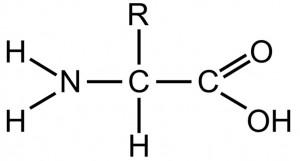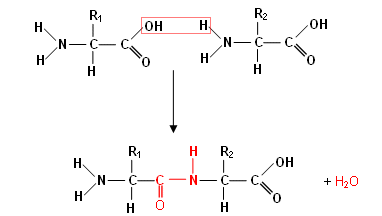an amino acid consists of a central (or alpha) carbon atom attached to an amino group, NH2, a carboxylic acid group, COOH, a hydrogen atom and a variable side group (called the R group). the R can represent one of 20 different side chains.

amino acids join together in an enzyme-catalysed condensation reaction between the amino group of one amino acid and the carboxyl group of another amino acid via peptide bond.

many amino acids join to form a polypeptide.

when a polypeptide is folded or coiled or associated with other polypeptide chains it forms a protein.
- the primary structure of a protein is the linear sequence of amino acids in the polypeptide chain.
- the secondary structure of a protein is the repeating pattern in the structure of the peptide chains, such as alpha helix or pleated sheets. this pattern arises when the positive on the amino group and the negative on the CO of the carboxyl group result in hydrogen bonding.
- the tertiary structure of a protein is the three dimensional folding of the secondary structure, held together by bonds between R side chains as well as hydrophobic interactions. these are:
hydrogen bonds, ionic bonds between ionised R groups, covalent bonds/ disulifde bridges between sulphur groups in cysteine, polar interactions, hydrophilic/polar groups arrange themselves on the outside of the protein and those that are hydrophobic/non-polar are on the inside.

- quaternary structure of a protein is the 3D arrangement of more than one tertiary polypeptide.
- it is the linear sequence of amino acids (the primary structure) that determines the protein’s 3D structure as the sequence of amino acids determine what bonds form between the amino groups and carboxyl groups (the secondary structure), which in turn affects where the R groups bond and how the protein will fold, which determines the protein’s precise three dimensional structure (its tertiary structure).
- the 3D structure of a protein determines its properties, which relate to its function:
a) globular proteins have a complex tertiary and sometimes quaternary structure (made up of multiple polypeptide chains), they’re coiled so that the hydrophilic/polar groups are on the outside of the protein and those that are hydrophobic/non-polar are on the inside, making globular proteins soluble so they’re easily transported in fluids.
b) fibrous proteins have little or no tertiary structure and parallel polypeptide chains are cross linked to form fibres, held by lots of bonds which makes the protein strong thus often acts as supportive tissue
Timonacic is a cyclic sulfur amino acid derivative with potential antineoplastic and antioxidant activities. Timonacic may induce malignant cells to revert back to an untransformed state. It may also restore contact inhibition, Timonacic
ReplyDeleteny style pizza greensboro nc At Moe's we believe that life is better with pizza. We are a fast-casual restaurant serving handcrafted pizzas, fresh salads, and decadent desserts. Order online for carryout or delivery today!
ReplyDelete